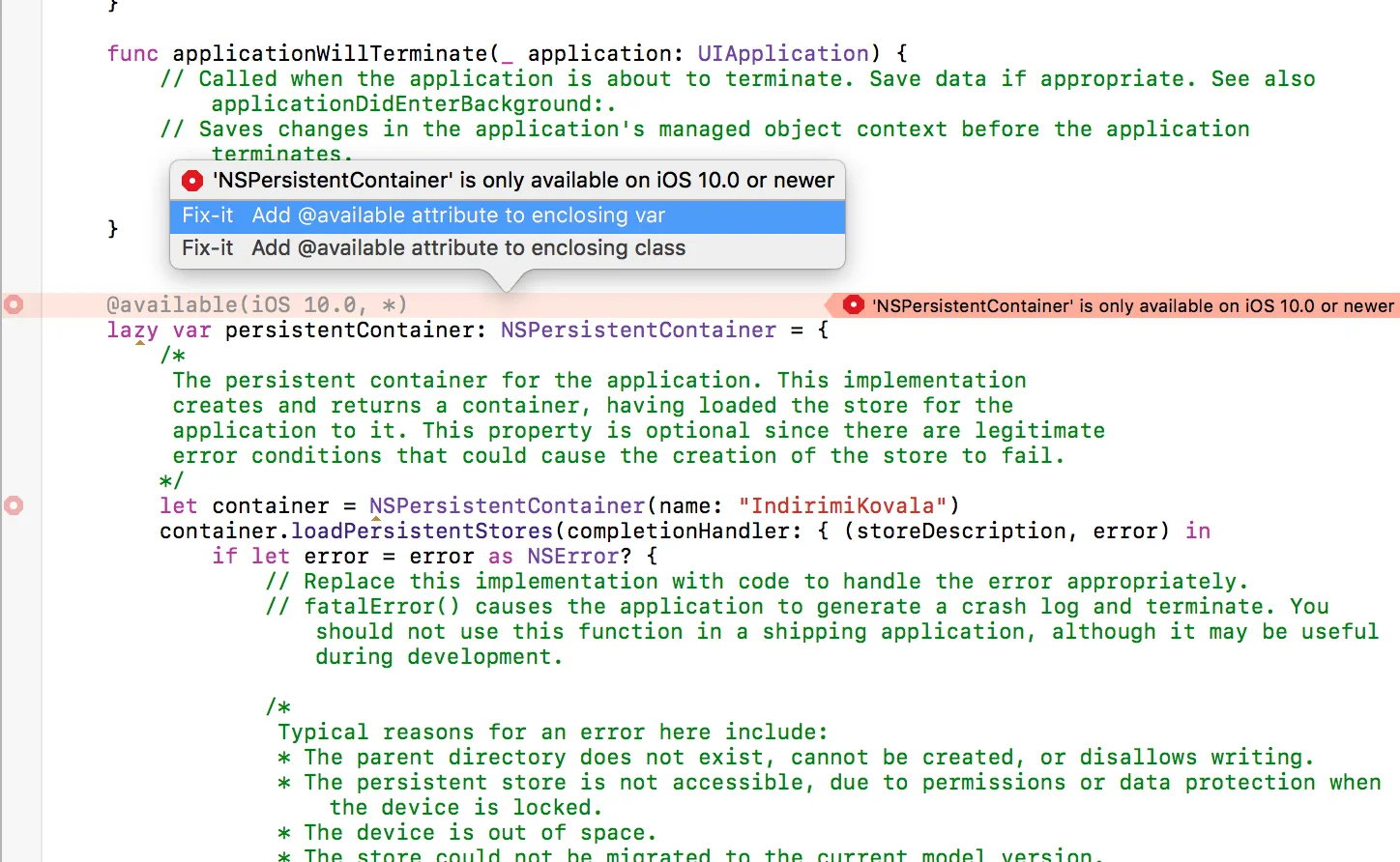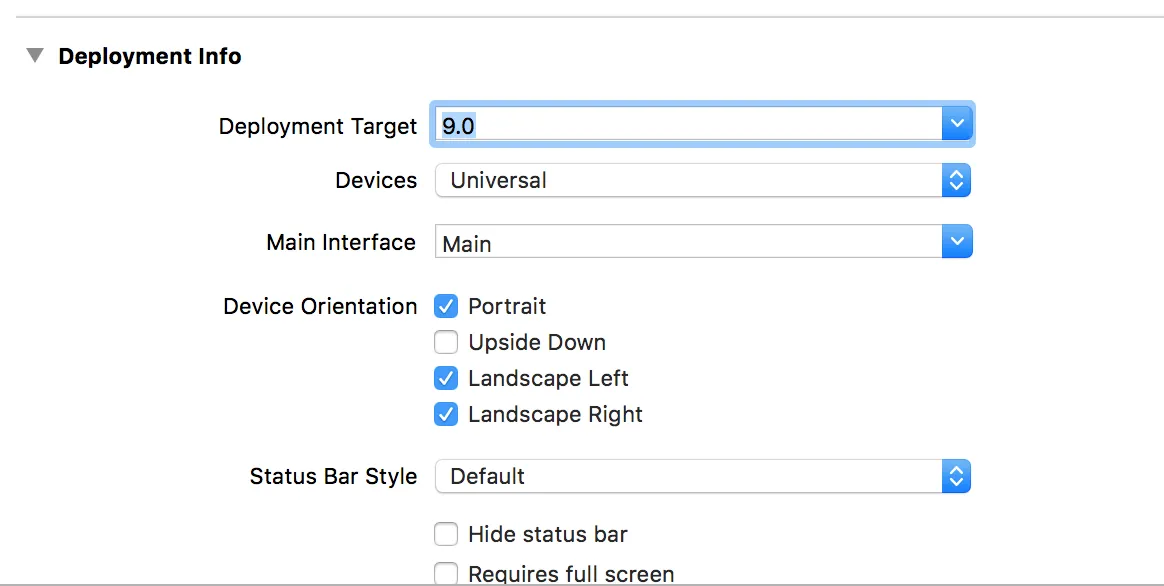Method 1 : AppDelegate
@available(iOS 10.0, *)
lazy var persistentContainer: NSPersistentContainer = {
let container = NSPersistentContainer(name: "coreDataTestForPreOS")
container.loadPersistentStores(completionHandler: { (storeDescription, error) in
if let error = error as NSError? {
fatalError("Unresolved error \(error), \(error.userInfo)")
}
})
return container
}()
lazy var applicationDocumentsDirectory: URL = {
let urls = FileManager.default.urls(for: .documentDirectory, in: .userDomainMask)
return urls[urls.count-1]
}()
lazy var managedObjectModel: NSManagedObjectModel = {
let modelURL = Bundle.main.url(forResource: "coreDataTestForPreOS", withExtension: "momd")!
return NSManagedObjectModel(contentsOf: modelURL)!
}()
lazy var persistentStoreCoordinator: NSPersistentStoreCoordinator = {
let coordinator = NSPersistentStoreCoordinator(managedObjectModel: self.managedObjectModel)
let url = self.applicationDocumentsDirectory.appendingPathComponent("SingleViewCoreData.sqlite")
var failureReason = "There was an error creating or loading the application's saved data."
do {
try coordinator.addPersistentStore(ofType: NSSQLiteStoreType, configurationName: nil, at: url, options: nil)
} catch {
var dict = [String: AnyObject]()
dict[NSLocalizedDescriptionKey] = "Failed to initialize the application's saved data" as AnyObject?
dict[NSLocalizedFailureReasonErrorKey] = failureReason as AnyObject?
dict[NSUnderlyingErrorKey] = error as NSError
let wrappedError = NSError(domain: "YOUR_ERROR_DOMAIN", code: 9999, userInfo: dict)
NSLog("Unresolved error \(wrappedError), \(wrappedError.userInfo)")
abort()
}
return coordinator
}()
lazy var managedObjectContext: NSManagedObjectContext = {
let coordinator = self.persistentStoreCoordinator
var managedObjectContext = NSManagedObjectContext(concurrencyType: .mainQueueConcurrencyType)
managedObjectContext.persistentStoreCoordinator = coordinator
return managedObjectContext
}()
static func getEntity<T: NSManagedObject>() -> T {
if #available(iOS 10, *) {
let obj = T(context: CoreDataStack.context)
return obj
} else {
guard let entityDescription = NSEntityDescription.entity(forEntityName: NSStringFromClass(T.self), in: CoreDataStack.context) else {
fatalError("Core Data entity name doesn't match.")
}
let obj = T(entity: entityDescription, insertInto: CoreDataStack.context)
return obj
}
}
func saveContext () {
if #available(iOS 10.0, *) {
let context = persistentContainer.viewContext
if context.hasChanges {
do {
try context.save()
} catch {
let nserror = error as NSError
fatalError("Unresolved error \(nserror), \(nserror.userInfo)")
}
} else {
if managedObjectContext.hasChanges {
do {
try managedObjectContext.save()
} catch {
let nserror = error as NSError
NSLog("Unresolved error \(nserror), \(nserror.userInfo)")
abort()
}
}
}
}
}
}
方法二:自定义类
创建一个名为CoreDataStack的Swift文件,并将以下代码复制粘贴到其中。
import UIKit
import CoreData
class CoreDataStack {
static var applicationDocumentsDirectory: URL = {
let urls = FileManager.default.urls(for: .documentDirectory, in: .userDomainMask)
return urls[urls.count-1]
}()
static var managedObjectModel: NSManagedObjectModel = {
let modelURL = Bundle(for: CoreDataStack.self).url(forResource: "DatabaseTest", withExtension: "momd")!
return NSManagedObjectModel(contentsOf: modelURL)!
}()
static var persistentStoreCoordinator: NSPersistentStoreCoordinator = {
let coordinator = NSPersistentStoreCoordinator(managedObjectModel: managedObjectModel)
let url = applicationDocumentsDirectory.appendingPathComponent("DatabaseTest.sqlite")
var failureReason = "There was an error creating or loading the application's saved data."
let options = [NSMigratePersistentStoresAutomaticallyOption: NSNumber(value: true as Bool), NSInferMappingModelAutomaticallyOption: NSNumber(value: true as Bool)]
do {
try coordinator.addPersistentStore(ofType: NSSQLiteStoreType, configurationName: nil, at: url, options: options)
} catch {
var dict = [String: AnyObject]()
dict[NSLocalizedDescriptionKey] = "Failed to initialize the application's saved data" as AnyObject
dict[NSLocalizedFailureReasonErrorKey] = failureReason as AnyObject
dict[NSUnderlyingErrorKey] = error as NSError
let wrappedError = NSError(domain: "YOUR_ERROR_DOMAIN", code: 9999, userInfo: dict)
NSLog("Unresolved error \(wrappedError), \(wrappedError.userInfo)")
abort()
}
return coordinator
}()
static var managedObjectContext: NSManagedObjectContext = {
let coordinator = persistentStoreCoordinator
var managedObjectContext = NSManagedObjectContext(concurrencyType: .mainQueueConcurrencyType)
managedObjectContext.persistentStoreCoordinator = coordinator
return managedObjectContext
}()
static func getEntity<T: NSManagedObject>() -> T {
if #available(iOS 10, *) {
let obj = T(context: CoreDataStack.context)
return obj
} else {
guard let entityDescription = NSEntityDescription.entity(forEntityName: NSStringFromClass(T.self), in: CoreDataStack.context) else {
fatalError("Core Data entity name doesn't match.")
}
let obj = T(entity: entityDescription, insertInto: CoreDataStack.context)
return obj
}
}
static func saveContext () {
if managedObjectContext.hasChanges {
do {
try managedObjectContext.save()
} catch {
let nserror = error as NSError
NSLog("Unresolved error \(nserror), \(nserror.userInfo)")
abort()
}
}
}
}
并将您的AppDelegate编辑为以下内容
import UIKit
import CoreData
@UIApplicationMain
class AppDelegate: UIResponder, UIApplicationDelegate {
var window: UIWindow?
func application(_ application: UIApplication, didFinishLaunchingWithOptions launchOptions: [UIApplicationLaunchOptionsKey: Any]?) -> Bool {
return true
}
func applicationWillResignActive(_ application: UIApplication) {
}
func applicationDidEnterBackground(_ application: UIApplication) {
}
func applicationWillEnterForeground(_ application: UIApplication) {
}
func applicationDidBecomeActive(_ application: UIApplication) {
}
func applicationWillTerminate(_ application: UIApplication) {
CoreDataStack.saveContext()
}
使用方法
这里的“Task”是我的实体名称。
func dummyData() {
let task: Task = CoreDataStack.getEntity()
task.title = "Hello World!"
CoreDataStack.saveContext()
}

